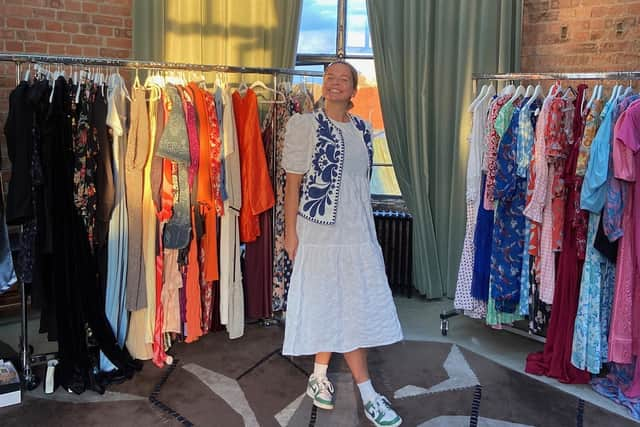How to shop more sustainably for clothing and avoid wasting money on fashion regrets
Research from Gumtree has found that people receive 10 alerts on average every week from fashion brands, encouraging them to make purchases.
But over a third (37%) of these rash purchases are later regretted, the survey indicates, costing both the planet and our purses.
Advertisement
Hide AdAdvertisement
Hide AdSome other recent analysis suggests, however, that the trend towards shopping more sustainably is making an impact.


According to Barclaycard Payments and economic impact analysts Development Economics, sustainable shopping is estimated to have contributed £6.99 billion to the UK’s economy in the past year, with just over £5.92 billion spent on second-hand products and £1.07 billion on renting items rather than buying new.
Alice Williams, 27, buys second-hand clothing to be sustainable and to save money.
“I used to be so impulsive and would be buying things that I didn’t really need and would never wear,” she says.
Advertisement
Hide AdAdvertisement
Hide Ad“I was often buying clothes, then not wearing them and they would sit in my wardrobe with the tags still on them. Looking back now, it was wasteful and I’m glad I’ve changed my shopping habits.”
Williams, who founded an online and pop-up second-hand fashion platform called REVIVA Collection, says her own finds have included a Burberry trench coat on Gumtree for £45. She also looks at clothes that can be rented for special occasions.
Williams, from London, suggests that when delving into the world of pre-loved fashion: “Always have an item that you want in mind when you are looking.
“Try to look for pieces that will really last throughout multiple seasons and years and avoid clothes that are too trend-based. It can be tricky when you are just starting out, but it really is worth it.”
Advertisement
Hide AdAdvertisement
Hide AdKeeping up with the latest trends can be pricey. Gumtree’s survey, carried out by Censuswide, also indicated that people spend more than £300 on average on new fashion items per year.
Handily, Hannah Rouch, a second-hand expert at Gumtree also has some tips for buying clothing more sustainably – and still keeping up with trends – or perhaps even setting your own:
1. Enjoy the trawl
“As the popularity of online second-hand shopping increases, so does the number of outlets and sellers,” says Rouch.
“Just like you would if shopping new, shop around to ensure you’re getting the best deal. Every minute you spend on research could save you pounds on your purchase. Once you find your perfect item, don’t be afraid to make an offer to keep costs low.”
2. Get to know your seller
Advertisement
Hide AdAdvertisement
Hide AdRouch adds: “One of the great things about buying second-hand is that it can be a much more personal experience.”
You can chat to the seller directly and ask what else they have coming up for sale.
But it’s also important to be aware of scammers. Santander recently issued a warning after dealing with a high number of disputes involving bogus “clearance” and “closing down” sales.
Rouch adds: “If shopping online, be suspicious if the price seems too good to be true. Never follow links without checking the URL and only complete the transaction if you are satisfied the seller is genuine.”
3. Invest in the classics
Advertisement
Hide AdAdvertisement
Hide AdWith Gumtree’s research indicating that many clothes purchases end up being regretted, Rouch suggests: “Invest first in staple pieces and let your wardrobe grow from there. Avoid fast fashion by handpicking classic [and/or] better-made items that can be worn through every season year after year – saving your purse and the planet.”
4. Shop for ‘out of season’ outfits
Buying sandals when it’s freezing cold outside or a cozy anorak in soaring temperatures may seem counter-intuitive.
But you’ll be competing with far fewer buyers looking for the same item and you may just find yourself a bargain.
Rouch says: “Transitional seasons such as spring and autumn are common for clear outs so opt for those times if you’re after choice. Plus, if you’re looking for high-end fashion, you might just get it at a high street price when looking off-season.”
5. Know your size
Advertisement
Hide AdAdvertisement
Hide Ad“Don’t be afraid to ask the seller for exact measurements or if you’re looking to buy from a specific brand, try the clothes on in store first so you have a good idea of how their clothes fit before you hit second-hand platforms,” suggests Rouch.
Also if you’re buying vintage clothing, remember that sizing has changed over the years. Some vintage sizes may be smaller than sizes for brand new items.
6. Hack the couture looks
Rouch adds: “Many of the designs seen on catwalks take inspiration from previous seasons and decades.
“Rather than buy new, check whether original items from the eras high fashion are drawing from are available. Searching for preloved clothing will also broaden your choice beyond the high street.”